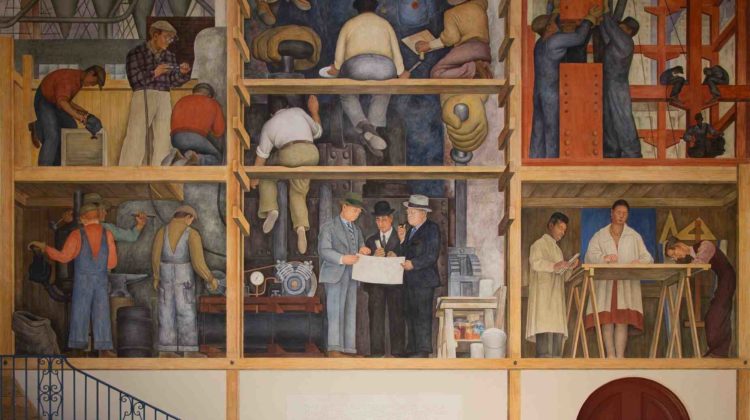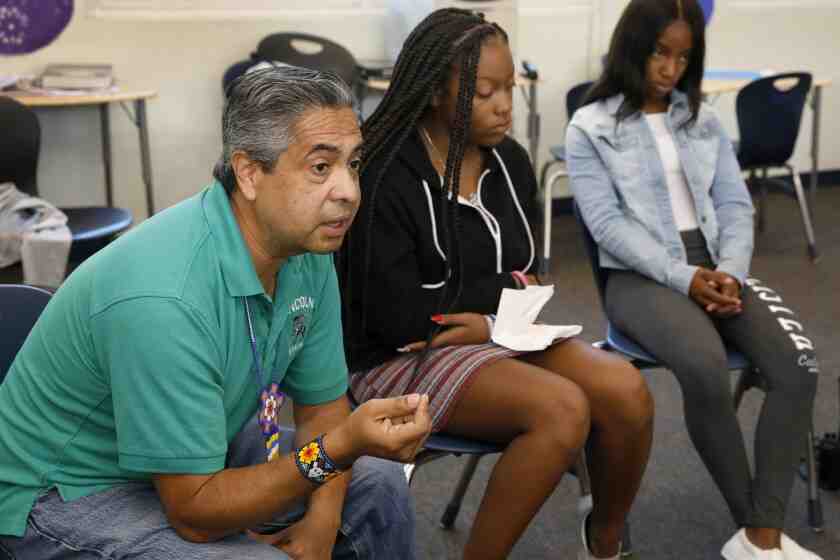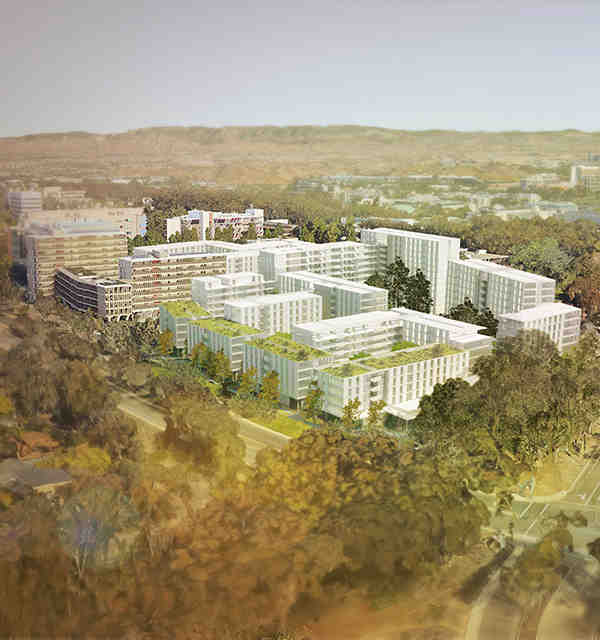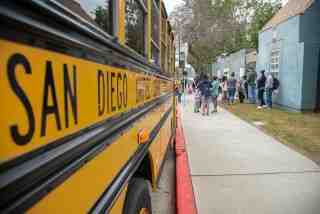
UC San Diego has opened a major conception center where thousands of students each year go from passive listening to lessons in design and product creation, primarily aimed at making people’s lives fuller, safer and healthier.
The $ 67 million Design and Innovation Building, or DIB, opened Nov. 18 and will allow students to develop everything from wake-up sensors that measure air quality to applications that screen for signs. from Alzheimer’s disease to scooters adapted for the elderly.
“We want students to engage and serve the community, to bring people together, rather than for the university to be an island in itself,” said Ramesh Rao, director of UCSD’s Qualcomm Institute, a technology test bank.
The approach reflects the university’s need to produce more workers for the region’s immense biotechnology, life sciences and engineering industry and its desire to more warmly welcome the public into a broader institution. isolated near the rocks of La Jolla.
The 74,000-square-foot DIB becomes the first piece of work for the university’s emerging “front door,” a clearly designated location where students and the public will find it easier to access the main campus, which spreads across to more than 600 acres.
The second piece, a Blue Line trolley station, will start operations on Sunday 21 November. It is located near the DIB, whose windows are designed to allow visitors and travelers to watch the action in the maker’s studios. A restaurant will be added to encourage people to stay.
An open-air amphitheater that will accommodate nearly 3,000 people is being built next to the DIB. And workers walk up and down Rupertus Lane, which provides people with the first clear path between the eastern and western edges of a campus that has nearly 43,000 students.
UC San Diego has long cultivated entrepreneurship and design among its students. But the effort began to take more focus and depth in 2014 when Chancellor Pradeep Khosla recruited renowned design expert Don Norman to found the school’s Design Lab and help conceptualize the DIB.
Design engineer and expert Don Norman was recruited to found the UCSD Design Laboratory and help design the Design and Innovation Building.
(Eduardo Contreras / San Diego Union-Tribune)
Norman is an engineer and psychologist who initially joined the UCSD faculty in 1966. He became founding president of the Department of Cognitive Sciences, the first department of its kind in the world.
He left UCSD in 1993 and became a research executive at Apple, helping the company to, among other things, improve its Macintosh computer.
Norman then went to other companies, including Hewlett-Packard, and proselytized his core belief that products should be easy to use and practical.
“The concept is not to do anything beautiful,” Norman told the San Diego Union-Tribune shortly after returning to UCSD. “It’s about making the world work better.
“I mean everything from your phone to health care to education to our impact on the environment. That’s what we’re focusing on.”
This will be one of the guiding principles at the DIB, which is made up of four floors, one of which hosts The Basement, an incubator space where students learn how to develop ideas and start a company.
The DIB is located in a place that until recently was a scraggly, little used area of campus.
“It’s gone from being a backwater to a part of our front door,” said Paul Roben, associate vice chancellor for innovation and marketing. “That’s great.” ◆
Is the University of San Diego a good school?

USD is also proud to be ranked by Washington Monthly as the No. 1 university in the nation committed to public service and ranked among the top universities in the 2020 Wall Street Journal / Times Higher Education College Rankings. Our Business School has ranked No.
Is UC San Diego a good school? UC San Diego is widely regarded by students as “one of the first scientific universities in the United States.” As a result, the school attracts brilliant students who benefit from “access to technology and cutting-edge theories.” and “great opportunities for students to do research.” The teachers “are incredibly …
Is University of San Diego hard to get into?
The acceptance rate at the University of San Diego is 48.7%. This means that the school is moderately selective. The school expects to meet its requirements for GPA and SAT / ACT scores, but they are more flexible than other schools. If it exceeds their needs, you have an excellent chance of entering.
What GPA do you need to get into University of San Diego?
To be eligible for admission to UC San Diego, you must earn the following minimum GPAs: California residents must earn a GPA of 3.0 (or better) without a lower grade of “C”. Non-California residents and international candidates must earn a GPA of 3.4 (or better) with no grade lower than “C”.
Is it harder to get into USC or UCSD?
If you’re just looking for the acceptance rate, then the University of Southern California (USC) is harder to get into. However, each university seeks to fill its incoming class with a variety of students with strengths, backgrounds, and so on.
Is University of San Diego an Ivy League?
Around the University of California, San Diego UCSD is among the Ivy Public colleges of the United States, whose goal is to provide students with the same quality of education as can be found in private colleges. of the Ivy League. As an important contributor to research activity, the university comprises 6 colleges.
Is university of San Diego a prestigious school?
1 university in the nation committed to public service and ranked among the top universities in the 2020 Wall Street Journal / Times Higher Education College Rankings.
Are there 8 or 12 Ivy League schools?
And 8 Ivy League Schools
- Brown University. …
- Columbia University. …
- Cornell University. …
- Dartmouth College. …
- Harvard University. …
- Princeton University. …
- University of Pennsylvania. …
- Yale University.
Is UCSD hard to get into?

The University of California San Diego is very difficult to enter. The 2025 UCSD Class had a pool of 98,669 candidates and accepted 37,584 students – giving the school an overall acceptance rate of 38%. The UCSD acceptance rate is low, but your personal chances of acceptance are tied to the strength of your profile.
Is it harder to get into UCLA or UCSD? Which school is easier to enter? If you’re just looking for the acceptance rate, then UCLA is harder to get into. However, each university seeks to fill its incoming class with a variety of students with strengths, backgrounds, and so on.
Is UCSD or UCSB harder to get into?
If you are only looking for the acceptance rate, then UC Santa Barbara is harder to get into. However, each university seeks to fill its incoming class with a variety of students with strengths, backgrounds, and so on.
Is UCSB harder to get into than UCI?
It is more difficult to admit to the UCSB than to the UCI. The UCSB has a higher sub-SAT score (1,345) than the UCI (1,330). The UCSB has a higher ACT score (31) than the UCI (30). UCI has more students with 36,303 students while UCSB has 26,179 students.
Which UCS is the hardest to get into?
UC Los Angeles UCLA is close to UC Berkeley. Both schools are the more competitive of the UC system, but with the lowest acceptance rate, UCLA is the hardest UC school to enter.
Is UCSD hard to get into out of state?
UC in San Diego admitted 51% of its candidates out of state compared to 26% of California residents who applied to be admitted. The numbers look similar to UC Santa Barbara, with 29% of admitted candidates residing in California and 47% coming from out of state.
Is it harder to get into UCLA as an out-of-state?
UCLA: Acceptance Rate – Class of 2023 This equates to only an acceptance rate of 12.3%. California residents were accepted at a 12% clip while out-of-state students were successful 16.4% of the time. However, as you will see in the next section, it is actually much more difficult to earn income as a non-resident.
Can you get into a UC out-of-state?
Despite a budget agreement in 2016 that the UC would limit its share of nonresident students to 18% on most of its campuses, Berkeley, UCLA and UC San Diego were allowed to keep their nonresident enrollment firm at about 23. %. Other top public universities in the United States average closer to 30%.
Is UCSD a party school?

UCSD is a nerdy school. Students study all the time since there are never any parties. UCSD is in La Jolla, which is known to be an old town so they didn’t want to make a football team since it would be too noisy in the city.
What is the number one party school in California?
Which UC school is a party school?
UCSB, pretty much or not, has probably earned the reputation of being the best party school. UCLA and UC Berkeley have a vibrant campus culture, great sports time and an active Greek life.
What is the #1 party school in the US?
| Ranking | School | Locu |
|---|---|---|
| 1 | University of Tulane | New Orleans, LA |
| 2 | Florida State University | Tallahassee, FL |
| 3 | University of Wisconsin – Madison | Madison, WI |
| 4 | Howard University | Washington DC |
Is UCLA a party school?
UCLA is definitely a party school; between Greek Life and the social scene Thursday through Sunday nights, you can definitely find a place to “jiggy with it”. However, UCLA students are also serious about their academics; they are very competitive and work hard to get good grades.
Is UCSD actually socially dead?
The typical impression of UCSD on others is a dead social school. However, this is not true. Students here tend to party carzy on weekends and holidays. But once you get close to midterms or finals, the environment becomes serious and the library is always packed.
Why is UCSD bad?
The only bad thing about UCSD is that it is not fully recognized by some as a highly competitive, top-level public school. It is very obvious that races / ethnicities are not on campus. For example, there are about 2% African American students compared to more than 40% Asian and white students.
Does UCSD have a social life?
But I am behind the change. In recent years, the school has cultivated a warmer and more open social climate, especially by adding better-designed housing that features fun restaurants, cool playgrounds, and neighborhoods for some of UCSD’s hundreds of student groups.
